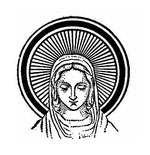
Return to the Message of Fatima
The story of Fatima has fascinated Catholics for the past one hundred years. Significantly, all nine popes who have guided the Church since 1917 have had a personal devotion to Our Lady of Fatima. Pope Francis, as archbishop of Buenos Aires, was a frequent visitor to a shrine in the Argentine capital devoted to her. He will make a papal visit to Fatima, Portugal, on May 12-13 to mark the hundredth anniversary of the apparitions. But no pope’s devotion to Our Lady of Fatima equals that of St. John Paul II. He even attributed his survival of an assassination attempt to Our Lady’s intervention. That attack took place on May 13, 1981, sixty-four years to the day after the Virgin Mary first appeared to three simple shepherd children: Lúcia dos Santos and her cousins, Francisco and Jacinta Marto.
In her first visitation to the children, Mary announced herself as Our Lady of the Rosary and called for devotion to her Immaculate Heart. She appeared to them five more times on the thirteenth day of each successive month. During the final apparition in October, the Virgin delivered on a promise she had made to the children that she would work a great miracle so that all would believe what the children had said was true. That day, October 13, 1917, despite a torrential downpour, seventy thousand people, including newspaper reporters and photographers, trekked to out-of-the-way Fatima to witness the much-anticipated event. They weren’t disappointed. When the hard rain finally ceased, the storm clouds parted and the sun shot down at the people, spinning like a flaming disk. The witnesses, whose clothes had been soaked through by the storm, left the scene dry, as if it had never rained. The event, later dubbed the Miracle of the Sun, was reported in a number of newspapers around the world, including The New York Times. A journalist for Portugal’s largest (and avowedly anti-clericabpnewspaper, O Século, described what he witnessed this way: “Before the astonished eyes of the crowd, whose aspect was biblical as they stood bare-headed, eagerly searching the sky, the sun trembled, made sudden incredible movements outside all cosmic laws. The sun ‘danced’ according to the typical expression of the people.”
During those earthly visitations, Our Lady revealed three “secrets” to the children. Lúcia, the only visionary to live to adulthood — she later became a cloistered Carmelite nun and died at the age of ninety-seven — explained in her Memoirs that the first message was delivered during the third appearance. After showing the children a vision of Hell, Mary said, “You have seen the destiny of souls of unfortunate sinners. In order to save these, the Lord wishes to spread devotion to my Immaculate Heart throughout the world. If the world does as I tell you, then many souls will be saved and there will be peace. The War [World War I] is about to end, but if men do not cease offending God, another worse war will begin in the reign of Pius XI [who was not yet Pope]. To avoid this affliction, I will entreat the consecration of Russia to my Immaculate Heart, and a penitential Communion on the first Saturday of the month. If my appeals are answered, Russia will be converted and there will be peace. Otherwise Russia will spread her errors throughout the world.”
At the time of the visions, as Sr. Lúcia later explained, she mistakenly thought that Russia was “a woman, a bad woman.” Instead, the first two “secrets” of Fatima predicted two of the most significant historical events of the twentieth century — the Bolshevik Revolution and the Second World War. On October 17, 1917, only four days after the final appearance of Our Lady in Fatima, the Russian communists forced Czar Nicholas II to abdicate the Russian throne. Under the orders of Vladimir Lenin, the entire royal family was put to death. We now know with the benefit of hindsight that the Virgin of Fatima was correct. Russia did “spread her errors throughout the world,” banishing God from its realm and persecuting Christians in Soviet-dominated countries by seizing property and killing and imprisoning bishops and priests. An American Jesuit, Fr. Walter Ciszek, wrote a fantastic and compelling eyewitness account of his experiences as a Catholic priest in Soviet Russia, titled With God in Russia (1964). It is well worth reading.
You May Also Enjoy
This Marian dogma is integrally related to the notion of our Lady as the Queen of Heaven or, rather, the queen mother of the Messiah, the Son of David.
Her huge diary is more than a memoir; it is a major corpus on one of the fundamental doctrines of Catholicism -- redemption.
Johnson retells the biblical story of Mary "subversively" to advance her cause; she reinterprets Mary's fiat at the Annunciation as "autonomy" and "choice."

